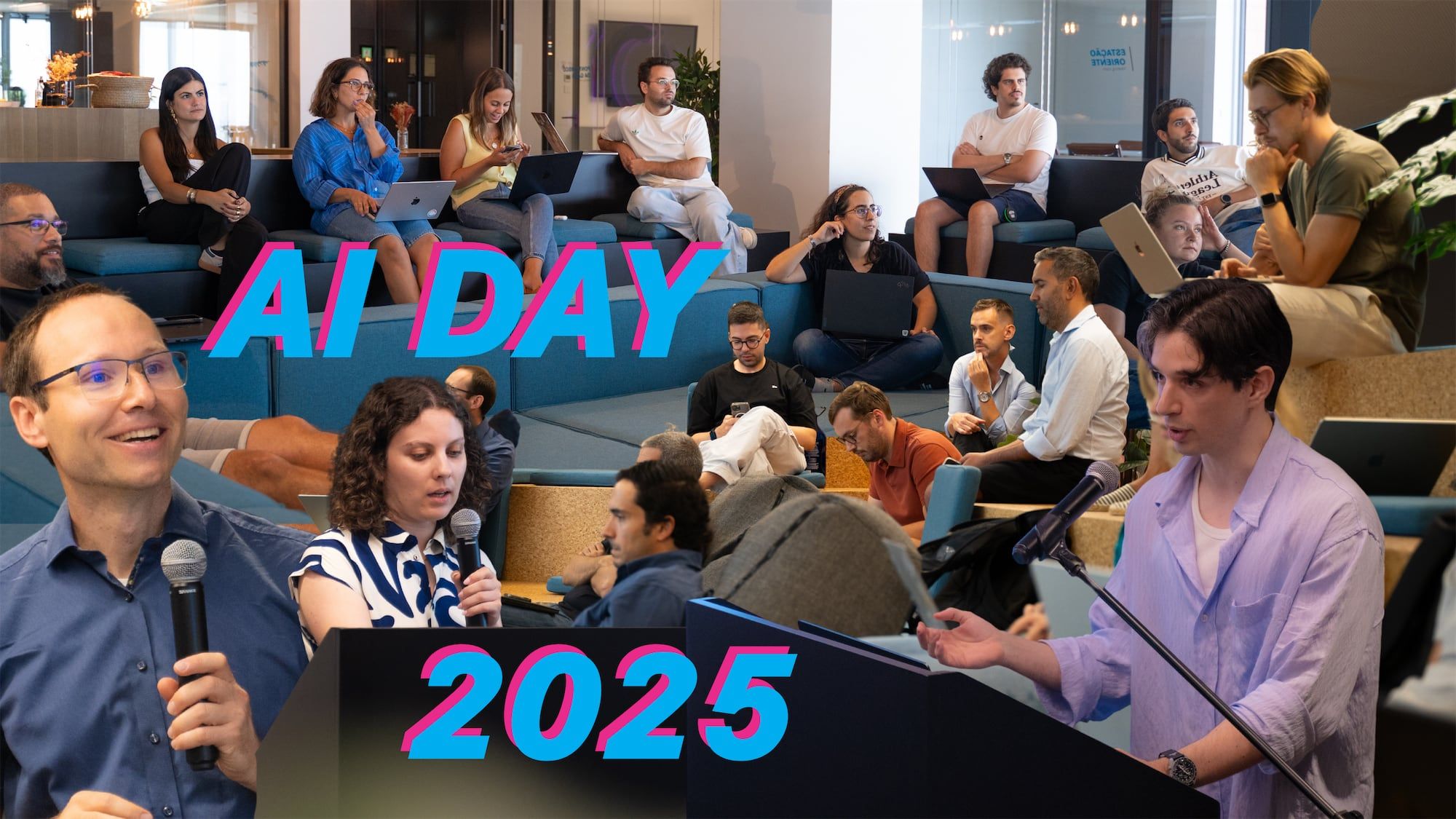
AI Day at Mercedes-Benz.io: Sharing Knowledge, Shaping Culture
What started as a simple question “How can we make AI more accessible for everyone at Mercedes-Benz.io” has grown into a journey of learning, experimentation, and shared curiosity. Through our AI Enablement Program, we’ve been laying the foundation: a series of sessions designed to help everyone feel confident to engage with AI, no matter their role.
But on July 17th 2025, we took it a step further.
The AI Day was more than just another event on the calendar. It was a full-day experience dedicated to exploring the present and future of AI at Mercedes-Benz.io. This day brought together MB.ioneers for a mix of inspiring talks and practical learning. From cognitive health to coding agents, we explored how AI is shaping our work and how we can shape it right back.
Let’s take a closer look at the sessions that defined the day, each one offering a unique lens into how AI is evolving and how we can evolve with it.
Contents
AI Meets E-Commerce: Designing for Intelligence, Not Just Interfaces
Speakers: Vanessa Costa, António Mascarenhas, Raphael Marques, and Tiago Matos
How do you design an AI experience that enhances online car shopping?
In this session, Vanessa Costa shared lessons from a recent project exploring how natural language and conversational design can support users in navigating complex digital journeys, like finding the right car online. From shaping the MVP to mapping out key interaction flows, the team worked through the early stages of building an AI-powered interface grounded in user needs.
Joined by frontend developers António Mascarenhas, Raphael Marques, and Tiago Matos, the discussion also covered the technical and strategic decisions that emerge when working across disciplines in AI projects.
Designing for AI, as Vanessa explained, required a completely new mindset:
As users, we're used to AI designing for us, but designing for AI means you're now creating for something that has its own intelligence. It's like having to relearn interface design entirely.
The team's goal was to create an experience that feels less like navigating a system and more like having a conversation, one that understands intent and reduces friction along the way.
As Vanessa put it best:
When you design for AI, you're not only creating an interface but orchestrating a conversation between technology and real human needs. That was the real challenge: the one that molded the design process.
Here are three takeaways that show how designing for AI challenges traditional UX thinking and how a user-focused strategy can turn complexity into clarity:
- Double Diamond Reality Check: The design process is rarely linear; initial expectations often shift when facing technical limitations, requiring adaptability and iteration at every stage.
- Collaboration as Foundation: Making AI work for users depends on close collaboration between design, development, and stakeholders, especially when navigating ambiguity and moving parts.
- Design for AI is Different: Creating AI-powered experiences means rethinking testing, feedback loops, and how data structures impact the end-to-end user journey.
Meet Carl.AI & Meet Carl.AI's API
Speaker: João Almeida
How can we build AI that truly understands our internal projects, processes, and people?
In these two sessions, João Almeida demonstrated how Carl.AI, our internal AI platform, bridges the gap between generic AI and an organization's specific, secure knowledge.
He explored two key pathways: first, how any employee can create a powerful, custom AI assistant in minutes without writing a single line of code, connecting it directly to data sources like Jira and Confluence. Second, he showed how developers can seamlessly integrate this secure, context-aware intelligence into their own applications and workflows using our simple, OpenAI-compatible API that includes built-in knowledge base access and a new Knowledge Base MCP server.
Who better than João himself to explain what this is all about:
With Carl.AI, you can build and integrate an AI that speaks with the authority of your own team's knowledge, whether through our web interface, developer APIs, or directly in your IDE.
These takeaways show how Carl.AI helps teams build smarter tools using their own knowledge, securely and simply:
- Your Data, Your AI: The real power of AI comes from securely connecting it to your own internal knowledge.
- Zero-to-Hero Accessibility: Anyone can create powerful, knowledge-aware AI assistants without writing a single line of code.
- Developer-First Integration: Carl.AI's OpenAI-compatible API means if you know OpenAI's interface, you already know ours. Carl.AI is a "drop-in" solution, bringing the power of secure, RAG-as-a-Service directly into your applications and even your IDE via MCP integration.
Model Context Protocol (MCP) + Spring AI: AI for Dummies
Speaker: Afonso Garcia
Why should building with AI feel any harder than building with LEGO?
Afonso Garcia introduced the Model Context Protocol (MCP) and the Spring AI project, starting with the current challenge: different LLM providers use different APIs, like cars with varying light controls, making migration difficult. MCP aims to standardize function calls, easing this transition, much like how car pedals remain consistent across models.
“If you're on the Spring ecosystem, Spring AI + MCP is the easiest way to provide context to your AI applications,” Afonso noted, highlighting how the tools simplify the developer experience.
To illustrate MCP's capabilities, he used Playwright to ask Claude about the current campaign on the Mercedes-Benz Germany homepage.
He then presented Spring AI, a project that simplifies AI development by abstracting the underlying LLM provider APIs. By simply changing configuration, developers can switch providers. Afonso demonstrated this with a sample to-do application, showing how to create an MCP server with Spring AI and use it with Claude.
The session wrapped up with a proof of concept for an AI gateway that converts REST and GraphQL services into MCP tools through YAML definitions.
This session made AI development easier to understand, here are three things that stood out:
- The Model Context Protocol (MCP) standardizes how LLMs fetch information from external sources.
- Spring AI facilitates the development of AI applications and enables code portability between different providers.
- The AI gateway pattern demonstrates how REST and GraphQL services can be transformed into MCP tools, making it even easier for developers.
Cognitive Health in the era of AI
Speaker: Ajith Jacob
How do we stay mentally sharp in an AI-driven world?
In this session, Ajith Jacob explained how our brain functions, with a focus on dopamine and how it responds to stimuli. He also discussed how we can take active steps to maintain our cognitive health.
He reflected on how, in past eras, we outsourced physical labor to machines and high-speed data processing to computers. Now, with AI, we face a new shift: the risk of offloading our thinking and decision-making capabilities. As AI is being adopted at an accelerating pace across industries, he emphasized that it is no longer something we can deny or avoid. Instead, we need to learn how to work with it, while staying aware of the risk of ‘cognitive offloading,’ or the mindless overdependence on AI for human thinking and judgment. As he put it:
Amplify your work with AI while keeping ownership and decision making to yourself.
Here are three important reminders about how to protect our brainpower while working with AI:
- Brain Rot and Cognitive dependence on AI is real: When we mindlessly depend on AI for all our thinking and decision-making needs, it is proven that our brain activity gets weaker on a permanent basis, and this also affects our long-term memory.
- AI in itself is inherently not bad. But how we use it matters: AI is an amazing invention of the modern era, which can be used to our advantage. For our own cognitive health, it’s important to have intellectual investment in the work we do, than we let go of ownership. The temptation to not review AI generated work should be overcome.
- We should use AI as an aid/amplifier of our work not a substitute for our own cognitive skills: Metacognitive Laziness (hyper-productive but losing motivation) is one of the side-effects if we overly depend on AI. It’s important to take full ownership of the work we produce.
Everyone's a Developer: The New Era of AI-Powered Development
Speaker: Jobrann Mous
How is AI evolving from a helpful assistant to an intelligent collaborator that enhances the developer experience?
In this 45-minute workshop, Jobrann Mous explored the evolution from traditional AI coding assistants to agentic AI systems that act as thoughtful development partners. The session demonstrated how agentic coding tools can handle routine tasks, assist with surface-level feature implementations, and help developers focus on architecture and complex problem-solving.
Reflecting on this shift, Jobrann explained the real impact these tools are already having on the development process:
Agentic AI understands context, plans solutions, and handles routine tasks, letting developers focus on architecture and innovation. It's extremely powerful, and it's here to stay. While it's not magic, it fundamentally changes who can build and how fast we can all iterate.
Through a live demo, attendees learned how agentic AI serves as a collaborative teammate, understanding project context, suggesting improvements, and handling repetitive implementation details while developers maintain control over critical decisions. The workshop also alluded to how these tools can help non-developers create prototypes and internal tools, freeing up developer time for more strategic work.
These takeaways show how AI is changing the way we build — and who gets to build:
- Context-Aware Intelligence: Unlike traditional AI, agentic AI understands your entire codebase, remembers patterns, and can reason through complex multi-step tasks autonomously.
- Tools for Every Skill Level: From CLI coding agents for complex integrations to no-code solutions suited to fast prototyping; there's now a spectrum of tools that empower both developers and non-developers to build faster.
- The New Development Reality: With code being increasingly AI-generated at lowered costs and faster times, the development landscape has fundamentally shifted - but human judgment remains irreplaceable for complex tasks, architecture, and critical decisions.
Future & Outlook of AI
Speaker: Daniel Thielsch
What happens when AI becomes as essential as electricity?
In the closing session, Daniel Thielsch explored the “transformative” claim about Artificial Intelligence (AI) and what that truly means. Using the analogy of AI as the new electricity, he explained how all groundbreaking technologies require time to diffuse and integrate into society. Today, while AI is being widely adopted across industries due to its novelty, it still grapples with core limitations like hallucinations, biases, and unreliability.
Daniel outlined short-term expectations such as tighter regulation, increased financial investment, and the development of more robust models. Looking further ahead, he presented a range of possible scenarios: from a complete halt in AI advancement to the rise of Artificial General Intelligence (AGI).
He also emphasized the need to reflect on how these shifts affect both our individual roles and how we develop products:
AI should be used only as a tool to complement human intelligence rather than replace its richness.
This distinction, he argued, is what will guide how we adapt and where we invest our efforts.
He underlined the importance of investing in reasoning and rigor, skills that distinguish humans from AI, and pointed to the potential need for product development approaches to evolve in ways that accommodate autonomous agents. While integration may be complex, he concluded that thoughtful, intentional adaptation will be key to navigating the changes ahead.
Here are three reflections on where AI is heading, and what we might need to adapt:
- AI is the new electrify: every technology has a “speed” limit, the time it takes to be completely adopted, including AI
- The future is blurry: While the short-term view is quite defined, the long-term of AI must be thought in scenarios, ranging from the very end of AI to AI surpassing human intelligence (AGI - Artificial General Intelligence)
- Changing our ways: Rethinking what makes our work valuable and how to design partial autonomous products is a key challenge and won’t be easy
In a constantly evolving environment, it’s easy to get caught up in the next sprint, the next release, the next challenge. But every now and then, we pause — to share what we’ve been building, learning, questioning. What made these sessions special wasn’t just the tech, the tools, or the insights — it was the people behind them, showing up to tell their stories.
Moments like this remind us why we do it: not just to stay ahead of what’s next, but to stay connected. To each other, to our craft, and to the questions that keep us curious. Because in the end, knowledge only really matters when it’s passed on — and culture is shaped every time we choose to share.
Related articles

Eduarda Cruz, Emna Maâlej, Hélia Freire
Women in Engineering: Stories of Belonging, Growth, and the Power of Support
Engineering shapes the world we live in. But the people shaping it don’t always reflect the world around us. Women in engineering still face barriers of access, representation and recognition. But they also bring resilience, innovation, and perspective that drive progress in ways that are both measurable and meaningful.
Jun 24, 2025

Raphael Marques
Facing New Challenges Within the Company: Embracing Growth Through Change
At the end of last year, I stepped outside of my comfort zone and changed teams.
May 21, 2025

Carolina Andrade
Why We Teach: Stories from Within
Some people are born to teach. Others stumble into it by accident.
May 14, 2025